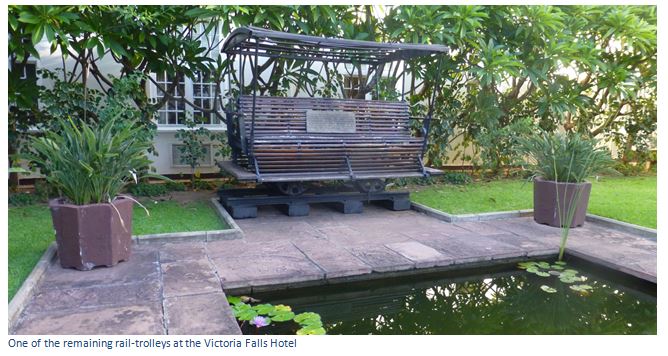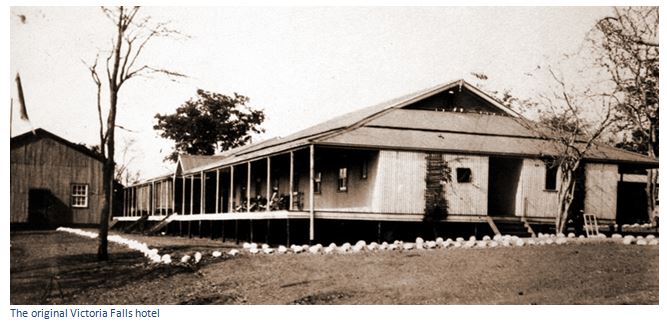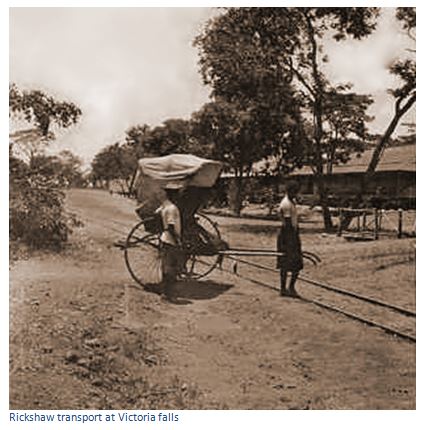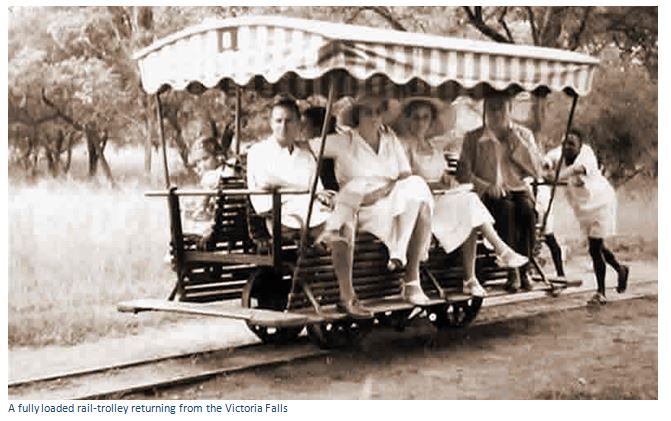Rickshaws and rail-trolleys at Victoria Falls
As for Victoria Falls entry
In 1874 Edwin Arnold, an editor with the London Daily Telegraph, had coined the phrase ‘Cape to Cairo’. A railway from the Cape to Cairo would measure over 9,000 kilometres if laid in a straight line. Rhodes soon realised the potential of the railway as the means to connect and consolidate British interests beyond the Cape and although this was never achieved, the remarkable penetration of rail into the heart of Africa brought much development to the region. Construction of the rail line from Bulawayo to Victoria Falls by the firm of Pauling and Co, led by George Pauling, was completed in May 1904, but before the first steam train had arrived in Victoria Falls, construction of the bridge had begun, all of which meant accommodation was needed.
The Victoria Falls Bridge opened on 12th September 1905; initially, it was Livingstone town that grew and there was little development at Victoria Falls town for many years. Apart from hotel staff, most of the population consisted of police, or railway officials and a handful of curio, or general dealers.
The railway company quickly saw the potential to open a hotel on a prime site in close proximity to the Falls. The original Victoria Falls hotel was intended only as temporary quarters for the railway employees, and was to be removed after construction of the bridge was complete. Two locomotive sheds in use on the Beira line were dismantled and sent to the Falls, one was commissioned as accommodation and the other as a dining room and they remained on site until 1917.
The Victoria Falls hotel opened for business on 8 June as a simple building of wood with a corrugated iron roof, well raised from the ground to afford ventilation and freedom from damp and pests. It consisted of 12 single rooms and four doubles, a dining room, a bar and offices. The manager was a colourful hotelier named Pierre Gavuzzi and the lowest tariff was 12/6d per day.
By the beginning of 1905, tourist traffic to the Falls had increased considerably and it was necessary to enlarge the accommodation at the hotel and by 1913, there were five excursion trains a year from Cape Town to the Victoria Falls and with the increased volumes of tourists, a decision was taken to rebuild the hotel in brick. The new building consisted of 24 bedrooms, two suites and five public rooms, which were the lounge, the writing room, the drawing and music room, the smoking room and the dining room.
After the First World War, tourism levels began to pick up again in the early 1920’s; visitors then numbered around 3,000 per year.
Percy M Clark
Percy M. Clark, originally one of the early settlers at the Old Drift on the north bank of the river had sensed an opportunity for business and moved to the south bank in 1903 and established the first curio, or souvenir shop, Clark's Curios. The original site, known as 'The Huts' was located opposite the railway station and doubled up as his photography studio and booking office - Clark was a photographer, and with the builders of the railway making steady progress towards the Falls and with the bridge engineers preparing to span the gorge, Clark saw potential in developing his small photography business, which he had started from the Old Drift.
When work began on the Victoria Falls Bridge in late 1904 he was asked by Sir Charles Metcalfe, the railway contractor, to document its construction and photograph the structure at varying stages of its erection. Metcalfe often came to Clark’s place, and if there were any visitors he always brought them over. Sir Charles was very popular with the men, who called him 'Uncle Charlie,' and he was a very good friend of Clark’s. Initially his main income was from sales of photographic postcards and small curios, but with the arrival of railway new opportunities developed.
Clark soon designed a portfolio of photographs of the Falls, entitled 'Souvenir of the Victoria Falls', of which there were several variations produced over the years, and he sold many, many thousands; his son, Victor Clark, who took over the photography business and continued producing the album in later years. Percy Clark became a local personality, later writing an autobiography of his adventures as a pioneer and photographer, and experienced a certain amount of fame from the early visitors to the Falls, who bought his postcards and photographs and sent them all over the world bringing the Victoria Falls to the wider world.
Clark recalls: the first through train from Cape Town arrived with a large party. The journey was apparently a grand adventure for these good people; the train was placarded through all its length and on both sides with legends informing the world how wonderful it was. On the Sunday I was visited by many of the excursionists, who bought photographs of the Falls.
In addition to 'The Huts', which served as his photography studio and shop, Clark established a stall at the recently opened railway station. An excursion train from the Cape was due to arrive late one evening and, the hotel being full, most of the passengers had to sleep in the train. I had the station bookstall, and I opened it that night with my wife and myself behind the counter. We did a roaring trade in pictorial post cards at four shillings a dozen and mahogany beans at three pence per pod. That first night we took twenty-eight pounds, and as the excursionists stopped three or four nights at the falls, our takings altogether served to put us on a fair footing.
At The Huts, our residence at the Falls, we often had nightly visitors, some of them were not very welcome. At this time the bush about the settlement had not been cleared to any great extent, and jackals would come and sit, giving tongue to their weird and very exasperating yowling. I would get up, go out, and fire my rifle in the direction of the howling, which, for the moment, would cease. But I would be no sooner settled down than the chorus would rise up again as exasperating as ever.
We had a couple of cows that we kraaled just outside our fence and their scent often brought lions round in the dark hours. We also had fowls, and leopards came after those - with more success than the lions. At the back of our place, about three hundred yards off, was the police camp, with donkeys and horses used for patrol work and the smell of them was an additional attraction for the lions.
Three young bloods decided one lovely moonlit night to sit up and shoot the lions that came on the prowl about the police camp practically every night. They climbed, the young bloods, not the lions, to the roof of the stables with their equipment. This included a bottle of whisky, and the hunters must have fortified themselves well, for they were fast asleep when the lions turned up. Oh yes! The lions turned up all right, because their spoor was to be seen all around the stables in the morning which goes to prove a quite elderly axiom that one cannot mix whisky with lion-hunting.
Clark claimed a series of notable 'firsts', being the first resident of Victoria Falls Town, establishing the first tourism business, and also the writer of the first guide to the Victoria Falls. The guide took the form of a day to day programme of walks and tours and general notes.
He made no attempt to describe the Falls in any detail, but was the first to give advice on attire: in the Rain Forest the oldest clothing, thick boots and a mackintosh are necessary, which latter should be worn until the hotel is reached. Experience teaches that it is advisable to wear the least possible amount of clothing. In the case of gentlemen a pair of old trousers and a sweater are all that is necessary, and ladies should wear their oldest clothes. The Wet Season (Summer) extends from November until the middle of April. Winter (during which there is no rain) the remainder of the year. Both in summer and winter it is advisable for gentlemen to have a helmet or wide-brimmed soft felt hat, and ladies should use at all times a sunshade (preferably a green-lined cotton article).
On a couple of his recommended walks, Clark observes; ladies are advised not to undertake the trip, as it entails a lot of climbing and hard exercise.
He also makes sure to mention his own claims to fame in relation to the local history of the Falls by saying that the gorge on the south side of the river was descended for the first time in February 1904 by C Beresford Fox and himself and stating he caught the first fish in the gorge, in the same month and year.
Canoes and boats
As early as 1908 Clark also ran river trips with a fleet of nine Canadian canoes, guests could be paddled across to Cataract Island from the southern bank and to Livingstone Island from the northern shore. In March 1911, Clark announced the arrival of his new motorised launch, called Inyandiza, which operated Sunday afternoon cruises from the old boathouse. All reservations were to be made by the Victoria Falls hotel to which Clark paid a percentage and they were advertised through his guide to the Falls: A whole day should be devoted to a trip up the magnificent Zambesi River. The trip may be made in Canadian canoes, paddled by expert Native boys, or in a modern, roomy and comfortable motor launch. The river trip is one of some seven miles up the river and above the Falls. Many picturesque islands are visited on the journey, the regatta course is negotiated, and ultimately Kandahar Island is reached, where a most enjoyable picnic can be held. After luncheon, the return journey should be commenced, say at about 2.30 pm, and a break made upon one of the charming islands for tea. The return trip is perhaps the more pleasant, as one catches the gorgeous tints of the setting sun on the tree-topped islands with their wealth of palm trees and semi-tropical growths, and the multi-coloured tints of the spray from the Falls, as seen from behind.
Clark also promoted trips to the islands on the lip of the Falls: From the middle of June until the end of December is it possible to visit Livingstone Island (originally named by David Livingstone ‘Garden Island’) the trip being made by canoe. The trees on which he carved his initials is still to be seen, and visitors should be careful not to mutilate it in any way. The whole of the Rainbow Fall is usually visible, and the view of the Main Fall is unique.
Recognising the business potential, the Victoria Falls Hotel soon made Clark an offer for his boating business, which he politely declined. The hotel promptly bought their own motor-launch and as nearly all the tourist visitors to the Falls stayed in the hotel, captured the majority of his business. This was the beginning of the hotel's involvement in providing tourist activities and transport, and established the competitive nature of business in a developing tourism town.
By the late 1920's the Victoria Falls Hotel ran two motor-launches on the river, the Daphne, accommodating 10 passengers, and the larger Diana. They ran two or three times a week across the river to Livingstone, and then up the river to Kandahar Island for afternoon tea. A third launch, the Dorothy, was later introduced.
Rickshaws
His proposal for a rail trolley service was politely received, but ignored. As Clark lacked the capital for the rail trolley service, he importing rickshaws from Durban to take tourists to the various points of interest in the vicinity of the Victoria Falls and they proved very popular. However, a price disagreement with administration officials led to the Victoria Falls Hotel becoming the owner and operator of the rickshaws. Yet again, Clark had lost out to big business.
Staff pushed trolleys
In 1920, the hand-worked rail trolley service first proposed by Percy Clark was built, as many guests visiting the Falls were elderly and found the existing walk, or rickshaw rides, too exhausting in the heat. A two-foot gauge track of 4 KM was constructed using ex-Beira railway material recovered from the Ayrshire Mine line, which ran from the hotel along the line of the original railway track which was washed away in the flood of 1909, crossing the main line to the rainforest and down to what was then the Southern Rhodesian end of the bridge, with a spur line continuing a short distance upstream along the banks of the Zambezi to the old boathouse, located half way along the current Zambezi Drive, where tourists could take river cruises before returning. This elevated track still runs parallel to the road and is used by tourists walking down to the ZWPMA entrance to the Victoria Falls today.
Gravity propelled the small four-wheeled trolleys with outward facing garden seats downhill to the Falls, but for the return journey which was uphill, usually two men pushed per trolley. Telephone boxes were installed at the terminus and junctions, so that a trolley could be summoned when required. The fare was one shilling each way; the trolleys were basically back to back garden seats under a striped canvas awning, carrying eight people. This service continued for the next 37 years until 1957; it is estimated that over two million passengers travelled on these trolleys. One trolley has been preserved and stands in the courtyard of the Victoria Falls Hotel; another is in the National Railways Museum at Bulawayo.
One tourist however was not so pleased with his trip. George Graves, a famous London comedian of the time, on a visit to the Falls in 1923, was injured in an accident when his trolley derailed, resulting in a claim for £2,000 being paid; clearly, he was not amused! The trolley service continued until December 1957 when buses were introduced.
Acknowledgement
P.M. Clark. The Autobiography of an Old Drifter. Books of Rhodesia. 1972
Rev. E.D. Hamer. Locomotives of Zimbabwe and Botswana. Stenvals, Sweden 2001




